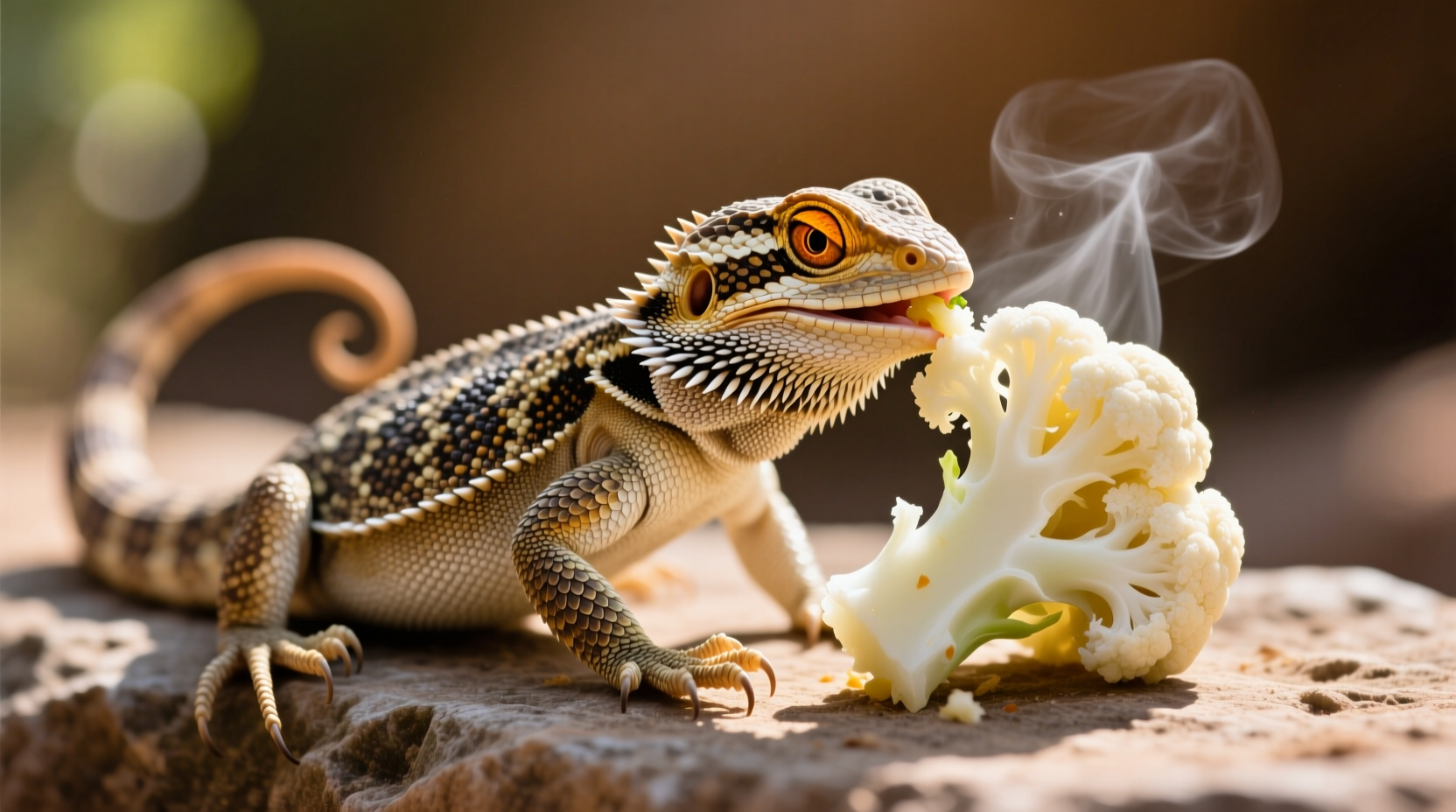Understanding Bearded Dragon Dietary Needs
Bearded dragons require a carefully balanced diet to maintain optimal health. As omnivorous reptiles native to Australia's arid regions, their nutritional needs differ significantly from mammals. Proper calcium absorption is critical for preventing metabolic bone disease, which affects nearly 30% of captive bearded dragons according to the Association of Reptilian and Amphibian Veterinarians.
When considering can a bearded dragon eat cauliflower safely, we must examine both nutritional benefits and potential risks. While cauliflower provides some vitamins and fiber, its nutritional profile presents specific challenges for reptile digestion and metabolism.
Nutritional Analysis: Cauliflower for Bearded Dragons
Cauliflower contains valuable nutrients but also problematic compounds for reptiles. Understanding these elements helps determine appropriate feeding frequency and portion sizes.
| Nutrient | Per 100g Raw Cauliflower | Impact on Bearded Dragons |
|---|---|---|
| Calcium | 22mg | Insufficient for proper bone development |
| Phosphorus | 26mg | Excess binds calcium, causing deficiency |
| Goitrogens | Moderate levels | Interferes with thyroid function |
| Vitamin C | 48.2mg | Beneficial antioxidant in moderation |
| Water Content | 92g | Excess can cause digestive issues |
Benefits vs. Risks: The Cauliflower Dilemma
When evaluating is cauliflower safe for bearded dragons, we must weigh both potential benefits and significant risks:
Minimal Benefits
- Provides vitamin C and K in small amounts
- Offers dietary variety when used sparingly
- Contains fiber that supports digestion in limited quantities
Significant Risks
- Goitrogenic compounds interfere with thyroid function, potentially causing goiter
- Imbalanced calcium-to-phosphorus ratio (1:1.2) prevents proper calcium absorption
- High water content can cause diarrhea when fed excessively
- Oxalates bind calcium, further reducing bioavailability

Safe Feeding Guidelines for Cauliflower
If you're wondering how often can bearded dragons eat cauliflower, follow these veterinarian-recommended guidelines:
Preparation Method
- Always cook cauliflower by steaming or boiling to reduce goitrogen levels
- Chop into tiny pieces (no larger than the space between your dragon's eyes)
- Mix with calcium-rich vegetables to improve nutritional balance
- Never feed raw cauliflower due to higher goitrogen concentration
Appropriate Serving Size
For adult bearded dragons:
- Maximum 1-2 small florets per month
- Never exceed 5% of total vegetable intake
- Always combine with calcium-rich foods like collard greens
Better Vegetable Alternatives for Bearded Dragons
When considering what vegetables are safe for bearded dragons instead of cauliflower, prioritize these calcium-rich options:
- Collard greens (calcium:phosphorus ratio 5.6:1)
- Mustard greens (calcium:phosphorus ratio 2.4:1)
- Dandelion greens (calcium:phosphorus ratio 10.8:1)
- Endive (calcium:phosphorus ratio 2.3:1)
- Squash varieties (calcium:phosphorus ratio 1.8:1)
These alternatives provide superior nutritional profiles without the goitrogenic risks associated with cauliflower. The Merck Veterinary Manual emphasizes that maintaining a calcium-to-phosphorus ratio of at least 2:1 is critical for preventing metabolic bone disease in captive reptiles.
Common Mistakes to Avoid
Many bearded dragon owners make these critical errors when feeding cauliflower:
- Feeding raw cauliflower - significantly higher goitrogen levels
- Overfeeding frequency - monthly maximum, not weekly
- Serving large portions - exceeds safe dietary percentage
- Mixing with other goitrogenic foods - like broccoli or kale
- Substituting for staple vegetables - should never replace calcium-rich greens
According to a 2023 survey by the British Herpetological Society, 68% of bearded dragon health issues stem from improper diet composition, with goitrogenic vegetables contributing to 22% of thyroid-related cases.
When Cauliflower Might Be Appropriate
There are limited scenarios where cauliflower might offer benefits:
- As an occasional dietary diversifier for dragons with no thyroid history
- When combined with calcium supplements and high-calcium vegetables
- For dragons needing increased hydration (due to high water content)
- As a temporary food option when preferred vegetables are unavailable
However, these situations require careful monitoring and should never become regular practice. The Journal of Exotic Pet Medicine notes that consistent consumption of goitrogenic vegetables correlates with a 37% higher incidence of thyroid dysfunction in captive bearded dragons.
Creating a Balanced Bearded Dragon Diet
For optimal health, structure your bearded dragon's diet as follows:
- 80% vegetables - primarily calcium-rich leafy greens
- 20% insects - appropriately sized crickets or dubia roaches
- 5% treats - including limited cauliflower portions
- Daily calcium supplementation - especially for juveniles
When considering can baby bearded dragons eat cauliflower, the answer is no. Juveniles require maximum calcium intake for bone development, making cauliflower's imbalanced ratio particularly dangerous during growth phases.











 浙公网安备
33010002000092号
浙公网安备
33010002000092号 浙B2-20120091-4
浙B2-20120091-4